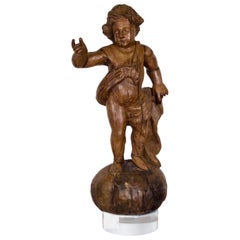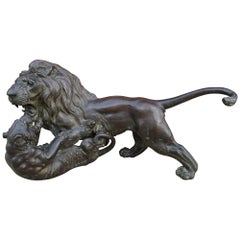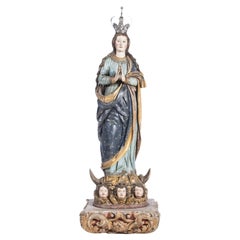Sculptures
Late 18th Century Italian Baroque Antique Sculptures
Wood
17th Century English Antique Sculptures
Oak
1910s Other Vintage Sculptures
Bronze
17th Century Portuguese Renaissance Antique Sculptures
Wood
1910s Austrian Art Nouveau Vintage Sculptures
Marble, Bronze
Early 17th Century German Baroque Antique Sculptures
Wood
18th Century Italian Rococo Antique Sculptures
Coral
15th Century and Earlier Egyptian Egyptian Antique Sculptures
Fruitwood, Hardwood
15th Century and Earlier Malagasy Adam Style Antique Sculptures
Rock Crystal
Early 18th Century Antique Sculptures
Alabaster
Late 18th Century Antique Sculptures
Bronze
15th Century and Earlier Pakistani Adam Style Antique Sculptures
Rock Crystal
17th Century Dutch Baroque Antique Sculptures
Oak
1910s Austrian Art Deco Vintage Sculptures
Bronze
1910s German Vintage Sculptures
Bronze
15th Century and Earlier Pakistani Adam Style Antique Sculptures
Rock Crystal
18th Century Italian Rococo Antique Sculptures
Quartz, Gold Leaf
Early 17th Century Asian Antique Sculptures
Ceramic
Late 17th Century Italian Louis XIV Antique Sculptures
Wood
1910s Austrian Art Nouveau Vintage Sculptures
Bronze
17th Century Brazilian Other Antique Sculptures
Wood
15th Century and Earlier Malagasy International Style Antique Sculptures
Stone
16th Century Spanish Gothic Antique Sculptures
Stone
Mid-18th Century English Baroque Antique Sculptures
Enamel
16th Century French Renaissance Antique Sculptures
Oak
16th Century German Antique Sculptures
Boxwood
16th Century German Renaissance Antique Sculptures
Wood, Pine
18th Century German Baroque Antique Sculptures
Wood
18th Century Spanish Antique Sculptures
Gold
15th Century and Earlier Brazilian Antique Sculptures
Stone, Metal
18th Century Italian Rococo Antique Sculptures
Rock Crystal, Quartz
15th Century and Earlier Brazilian Antique Sculptures
Agate
1910s American Industrial Vintage Sculptures
Wood
15th Century and Earlier British Prehistoric Antique Sculptures
Stone
15th Century and Earlier Central African Adam Style Antique Sculptures
Rock Crystal
18th Century Italian Rococo Antique Sculptures
Quartz, Rock Crystal
Late 18th Century American Antique Sculptures
Gold Leaf
18th Century French Antique Sculptures
Wood
15th Century and Earlier Central African Adam Style Antique Sculptures
Rock Crystal
18th Century Italian Baroque Antique Sculptures
Wood
1660s French Baroque Antique Sculptures
Oak
1910s German Beaux Arts Vintage Sculptures
Bronze
18th Century Italian Louis XVI Antique Sculptures
Wood
1780s French Other Antique Sculptures
Terracotta
18th Century and Earlier Italian Other Antique Sculptures
Stucco
18th Century Italian Rococo Antique Sculptures
Quartz, Rock Crystal
Mid-17th Century Italian Other Antique Sculptures
Carrara Marble
1660s Antique Sculptures
Alabaster
15th Century and Earlier Italian Other Antique Sculptures
Wood
16th Century Chinese Antique Sculptures
Ceramic
15th Century and Earlier Congolese Tribal Antique Sculptures
Copper
17th Century Italian Renaissance Antique Sculptures
Marble
15th Century and Earlier Japanese Other Antique Sculptures
Cypress
Mid-18th Century Burmese Other Antique Sculptures
Bronze
18th Century Italian Rococo Antique Sculptures
Coral
16th Century Italian Other Antique Sculptures
Wood
16th Century Chinese Antique Sculptures
Ceramic
Late 18th Century Chinese Chinese Export Antique Sculptures
Porcelain
Antique, New and Vintage Sculptures
Styling your home with vintage, new and antique sculptures means adding a touch that can meaningfully transform the space. By introducing a sculptural work as a decorative finish to any interior, you’re making a statement, whether you tend toward the dramatic or prefer to keep things casual with modest, understated art.
A single, one-of-a-kind three-dimensional figurative sculpture mounted on your dining room wall is a guaranteed conversation piece, while a trio of abstract works arranged on your living room bookshelves can add spontaneity to the collection of first-edition novels or artist monographs you’re displaying as well as draw attention to them. Figurative sculptures are representational works that portray a specific person, animal or object. And while decorating with busts, which are sculpted or cast figurative works, hasn’t exactly topped the list of design trends every year, busts are back. According to designer Timothy Corrigan, “They give humanity in a way that a more abstract sculpture can’t give.” Abstract sculptures, on the other hand, are not meant to show something specific. Instead, they invoke a mood or scene without directly stating what they are portraying.
Busts made of stone or metal may not seem like a good fit for your existing decor. Fortunately, there are many ways for a seemingly incongruous piece to fit in with the rest of your room’s theme. You can embrace a dramatic piece by making it the focal point of the room, or you can choose to incorporate several elements made out of the same material to create harmony in your space. If an antique or more dramatic piece doesn’t feel like you, why not opt for works comprising plastic, fiberglass or other more modern materials?
When incorporating sculpture into the design of your home — be it the playful work of auction hero and multimedia visionary KAWS, contemporary fiber art from Connecticut dealer browngrotta arts or still-life sculpture on a budget — consider proper lighting, which can bring out the distinctive aspects of your piece that deserve attention. And make sure you know how the size and form of the sculpture will affect your space in whole. If you choose a sculpture with dramatic design elements, such as sharp angles or bright colors, for example, try to better integrate this new addition by echoing those elements in the rest of your room’s design.
Get started on decorating with sculpture now — find figurative sculptures, animal sculptures and more on 1stDibs today.
Read More
These Soft Sculptures Are Childhood Imaginary Friends Come to Life
Miami artist and designer Gabriela Noelle’s fantastical creations appeal to the Peter Pan in all of us.
Salvatori Commissioned Several Famous Architects to Create Miniature Homes in Stone
Gabriele Salvatori explains how the COVID lockdowns inspired his design company's latest collection, the Village.
Christopher Norman Is Turning the Cast-Off Urban Trees of Los Angeles into Art
With a World War II–era milling machine, the California artist crafts poetic, sculptural furniture pieces.
These Human-Size Ceramic Hares Evoke Serious Emotions
Swedish artist Margit Brundin's large anthropomorphic animal sculptures are on view for the first time in the United States at Dienst + Dotter Antikviteter, in New York.
Tour the Wabi-Sabi New York Apartment of Andrianna Shamaris
As her sun-filled home reveals, the furniture maker and dealer puts a contemporary spin on antiques from around the globe.
Vicente Wolf’s Tips for Finding — and Living with — Eastern Treasures
The A-list designer shares his expertise on choosing authentic objects and displaying them with style.
Rodrigo Rivero Lake’s Mexico City Showroom Is a Museum-Worthy Trove of Spanish Colonial and Asian Antiques
The dealer and curator has spent the past 50 years amassing a collection of exceptional art, furniture and architectural elements that trace the cultural influence of the Spanish empire from Europe to the Americas and beyond.
Misha Kahn Is the Millennial Maker for Our Anxious Times
The Study catches up with the Brooklyn designer as he prepares for his second solo show at Friedman Benda.





